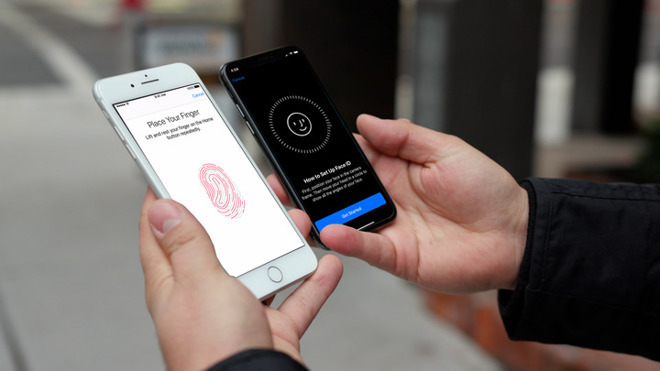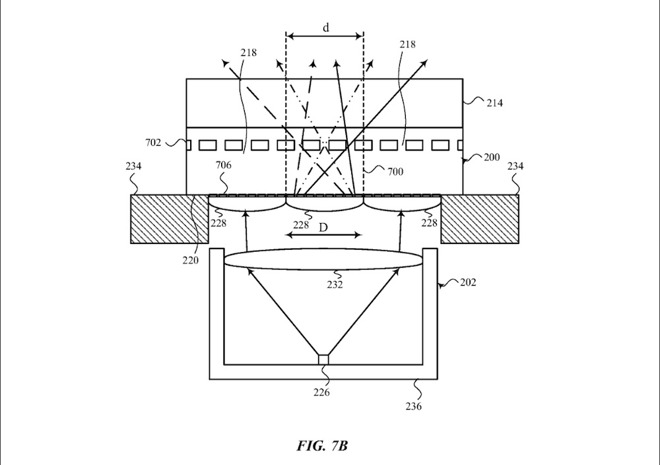Apple is still working on under-display optical Touch ID reader
Apple is continuing development of optical under-display fingerprint reading technology, possibly for a future iPhone.

Credit: Apple
Although Apple's iPhones haven't featured Touch ID for several generations now, there have been ongoing rumors that the company is looking into bringing the technology back. Past patent applications have also hinted at this.
One Wednesday, the U.S. Patent and Trademark Office published two Apple patent applications related to the technology.
The first, titled "Through-Display Optical Transmission, Reception, or Sensing Through Micro-Optic Elements," details optical sensors that are embedded beneath a device's display. It opens with a background stating that it may "be desirable to capture a two-dimensional (2D) or three-dimensional (3D) image of an object or user that is proximate to a device," such as a fingerprint.
With an optical sensor, receiver or transmitter positioned behind a display, the patent says that "light may be transmitted or received through translucent apertures extending from a front surface to a back surface of a display stack of the device."
"In this manner, an optical transmitter, receiver, or sensor may transmit or receive "through" a display," the patent reads.
Display stacks aren't always 100% translucent, and Apple notes a method to deal with opaque components. Specifically, some opaque elements could be opaque to "some wavelengths of light ... but translucent to other wavelengths." Getting around those opaque elements could involve placing translucent apertures throughout a display that extends beyond the opaque elements. From there, light can be collimated and directed through the apertures and toward an optical receiver or micro-lens array.
"For example, in some cases, a micro-lens array may be formed on the back surface of the display stack," the patent reads. "Each micro-lens in the array may have a focal point located with, aligned with, or near one of the translucent apertures."
Combined with a similar optical transmitter, the technology could allow for fingerprint reading through a display surface (and in spite of non-transparent display components).

An illustration of the micro-lens array and transparent aperture setup. Credit: USPTO
Its inventors include Tong Chen, Mark T. Winkler, Meng-Huan Ho, Rui Liu, Xiao Xiang and Wenrui Cai. Of them, Chen has previously worked on patents related to laser-powered AirDrop.
The second patent published today, "Optical-Fingerprint Detection System," details a method of temperature compensation in an optical fingerprint detection system.
In an apparent effort to combat the effects of temperature on OLED-based displays, this patent describes a method to compensate for differences in temperature between signals.
"A temperature compensated signal reading can be produced by subtracting the first reading from the second reading," the patent reads.
Other portions of the patent describe various implementations, voltage specifications and component structures for an optical fingerprint sensor embedded within a display.
The two inventors of this patent are Mohammed Yeke Yazdandoost and Christoph H. Krah. Yazdandoost has previously worked on biometric imaging and touch detection technology, and Krah has been named in similar optical Touch ID patents.
As mentioned earlier, Apple has continued its work on potential under-display fingerprint sensing technology since ditching Touch ID on the iPhone X in 2017.
In April, a supply chain report suggested that Apple may tap partners for under-display fingerprint sensors. While Ming-Chi Kuo has forecast that a Touch ID-equipped iPhone could arrive in 2021. Along with optical solutions, Apple is also exploring acoustic-based imaging for fingerprint detection.
Patent applications are poor indicators of Apple's future product plans, however. They also don't give any sort of timeline as to when such devices could arrive on the market.

Credit: Apple
Although Apple's iPhones haven't featured Touch ID for several generations now, there have been ongoing rumors that the company is looking into bringing the technology back. Past patent applications have also hinted at this.
One Wednesday, the U.S. Patent and Trademark Office published two Apple patent applications related to the technology.
The first, titled "Through-Display Optical Transmission, Reception, or Sensing Through Micro-Optic Elements," details optical sensors that are embedded beneath a device's display. It opens with a background stating that it may "be desirable to capture a two-dimensional (2D) or three-dimensional (3D) image of an object or user that is proximate to a device," such as a fingerprint.
With an optical sensor, receiver or transmitter positioned behind a display, the patent says that "light may be transmitted or received through translucent apertures extending from a front surface to a back surface of a display stack of the device."
"In this manner, an optical transmitter, receiver, or sensor may transmit or receive "through" a display," the patent reads.
Display stacks aren't always 100% translucent, and Apple notes a method to deal with opaque components. Specifically, some opaque elements could be opaque to "some wavelengths of light ... but translucent to other wavelengths." Getting around those opaque elements could involve placing translucent apertures throughout a display that extends beyond the opaque elements. From there, light can be collimated and directed through the apertures and toward an optical receiver or micro-lens array.
"For example, in some cases, a micro-lens array may be formed on the back surface of the display stack," the patent reads. "Each micro-lens in the array may have a focal point located with, aligned with, or near one of the translucent apertures."
Combined with a similar optical transmitter, the technology could allow for fingerprint reading through a display surface (and in spite of non-transparent display components).

An illustration of the micro-lens array and transparent aperture setup. Credit: USPTO
Its inventors include Tong Chen, Mark T. Winkler, Meng-Huan Ho, Rui Liu, Xiao Xiang and Wenrui Cai. Of them, Chen has previously worked on patents related to laser-powered AirDrop.
The second patent published today, "Optical-Fingerprint Detection System," details a method of temperature compensation in an optical fingerprint detection system.
In an apparent effort to combat the effects of temperature on OLED-based displays, this patent describes a method to compensate for differences in temperature between signals.
"A temperature compensated signal reading can be produced by subtracting the first reading from the second reading," the patent reads.
Other portions of the patent describe various implementations, voltage specifications and component structures for an optical fingerprint sensor embedded within a display.
The two inventors of this patent are Mohammed Yeke Yazdandoost and Christoph H. Krah. Yazdandoost has previously worked on biometric imaging and touch detection technology, and Krah has been named in similar optical Touch ID patents.
As mentioned earlier, Apple has continued its work on potential under-display fingerprint sensing technology since ditching Touch ID on the iPhone X in 2017.
In April, a supply chain report suggested that Apple may tap partners for under-display fingerprint sensors. While Ming-Chi Kuo has forecast that a Touch ID-equipped iPhone could arrive in 2021. Along with optical solutions, Apple is also exploring acoustic-based imaging for fingerprint detection.
Patent applications are poor indicators of Apple's future product plans, however. They also don't give any sort of timeline as to when such devices could arrive on the market.
This discussion has been closed.

Comments
Additionally, maybe this can pave the path for notchless iPhones.
I mean Face ID is cool, but I would not miss it (I mean maybe I would miss Animoji) if the fingerprint scanner was put into the screen.
Full screen iPhones will be really cool and sleek looking. Apple tends to focus heavily on aesthetics, and most people who follow apple probably know what their design goals are generally.
On another note, I have a fun conspiracy theory with regards to Face ID. What if the purpose of Face ID was to get dimensions of peoples faces so when the apple glasses product is available, they would be fitted with the appropriate size and there would be no risk of poorly fitted glasses. Probably not the case given Apple's stance on privacy, but you never know.
There's other iPhones with display TouchID? Show me.
WAIT WHAT?? You actually think Apple will remove FaceID?!!
You may not be aware of what is going on in Android world. Samsung is the ONLY Android OEM who has been implementing the touch id under display wrongly for last 2 years. All of the Chinese OEMs (BBK subsidiaries, Huawei, Xioami etc) and others have got it right for quite some time now (more than 1 year).
Since when has the real iPhone been "late" to the party of knockoff developers? Name an iPhone that has display TouchID.
Also "got it right" is just history repeating itself. Everyone thinks they "got it right" before Apple comes in and does it THE RIGHT WAY. You're not thinking enough just regurgitating typical anti-Apple BS that we've heard over the past 15 years.
Examples of companies who "did it first" and "got it right"
Google Wallet
Blackberry/Nokia
Microsoft Hello
Microsoft tablets
Pebble
All of the Chinese OEMs (BBK subsidiaries, Huawei, Xioami etc) and others have got it right for quite some time now (more than 1 year)
HP Laptops touch buttons
Remember those arguments? Ah..... the days when people called ApplePay a failure because "My knockoff iPhone has Google Wallet!" before the industry copies pple PAy.
Maybe the patent is for an AI-related sensor that senses the presence and fires up the Face ID, unlocking the phone, even before one reaches for the device.
That's the stuff Apple is (should be) thinking about, not resurrecting ancient features.
But yeah, I'm on record of saying I want it as well as FaceID, but also that I know of people with use cases where FaceID is no use to them. So I think it should be configurable either as an alternative to FaceID or to work in combination with FaceID for additional security.
Buh huh …
Buh huh Bwah hahahahahaha!! 🤣
There, I've just fixed your problem.
They don’t need a dedicated finger sensor for that. They can simply activate it when you put your finger on the screen. And if you swipe up on a locked screen then the phone will activate FaceID anyway.
We don't know that the patent is for a fingerprint sensor or a sensor embedded in the display that senses the approach of an object like a hand.